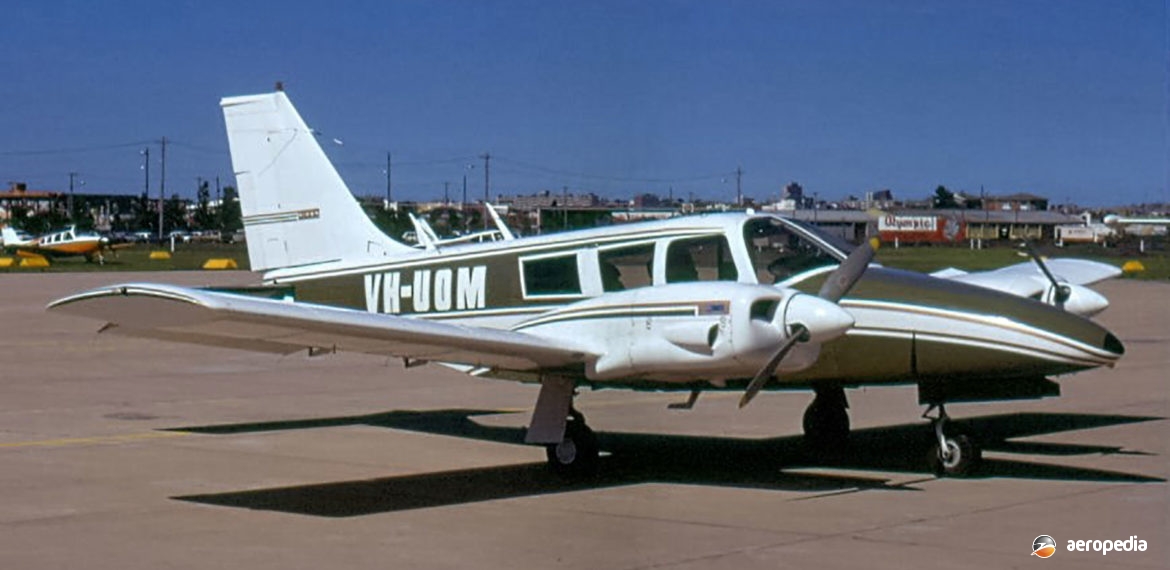Photograph:
Piper PA-34-200 Seneca VH-UOM (c/n 34-7350032) at Mascot, NSW in January 1974 (David C Eyre)
Country of origin:
United States of America
Description:
Light twin-engine business and executive aircraft
Power Plant:
Two 149 kw (200 hp) opposite-rotating Continental TSIO-360-E four-cylinder horizontally-opposed air-cooled engines
Specifications:
- Wingspan: 11.85 m (38 ft 10¾ in)
- Length: 8.73 m (28 ft 7½ in)
- Height: 3.02 m (9 ft 10¾ in)
- Wing area: 19.39 m² (210.7 sq ft)
- Max speed at 4,265 m (14,000 ft): 367 km/h (228 mph)
- Economical cruising speed at 7,315 m (24,000 ft): 301 km/h (187 mph)
- Initial rate of climb: 408 m/min (1,340 ft/min)
- Max operating altitude: 7,620 m (25,000 ft)
- Range with standard fuel and reserves: 1,128 km (701 miles)
- Empty weight: 1,264 kg (2,788 lb)
- Loaded weight: 2,073 kg (4,570 lb)
History:
The Seneca was developed from the Piper Cherokee Six series, basically being a twin-engine version with the fuselage of the Cherokee Six, using the Cherokee Six’s wings, horizontal tail and fuselage, standard single and optional double rear loading doors and single front door, with a new wing centre section so two engines could be installed, and a retractable undercarriage. Initially known as the Twin-Six, and developed using initially three engines, and later two, the prototype with two 119 kw (180 hp) engines was flown in August 1968 and was certificated by the American FAA on 7 May 1971. Production deliveries began during that year, the first aircraft being delivered in April 1971. The third prototype was more representative of the definitive production series, having two 149 kw (200 hp) Lycoming IO-360-A1A engines driving contra-rotating propellers.
Following its introduction, Piper described it as ”combining the spaciousness of twins that cost nearly twice as much, with a low cost and operating economy…and to top it all, this carefully engineered airplane is a dream to fly.” Development continued over a number of years and through a number of models, each with small refinements made to the design. In 1974 an extra cabin window was installed. Progress led to the Seneca II, and in 1978 the first major change was made with horizontal tail surfaces being fitted on top of the fin in the form of a T-tail similar to most of the Piper range at that time.
The Seneca was produced alongside the Twin Comanche until 1973, when the latter was discontinued. In 1979 optional three-blade propellers with a propeller synchro-phaser were introduced. (A synchro-phaser electronically seeks and maintains propeller synchronisation.) Later models had Teledyne Continental counter-rotating engines with permanent turbo-charging. The engines were rated at 149 kw (200 hp) at sea level and 160 kw (215 hp) at 3,658 m (12,000 ft). During the first three years of production 933 were delivered. Optional fuel tanks permitted a range of 1,448 km (900 miles) with 45 minutes reserve.
Subsequently the Piper Seneca III appeared in February 1981 with up-rated engines and airframe modifications to improve fuel efficiency. Piper stated that this new model would replace the Aztec, production of which concluded late in 1982. In May 1974 the PA-34-200T was flown and was fitted with 149 kw (200 hp) turbo-charged Continental TSIO-360-E six-cylinder engines in new design nacelles. To improve handling, aerodynamically balanced and lengthened ailerons, a re-designed stabilator and an anti-service tab for improved rudder effectiveness were installed. Gross weight was increased to 2,073 kg (4,570 lb). This variant, the Seneca II, was also licence-built from 1979 in Poland, initially being fitted with Polish-built Franklin engines but later the Continental. Kits over the years have been supplied to Argentina and Brazil where they were assembled. Production of the Seneca II totalled 2,588 aircraft delivered between 1975 and 1981.
In 1978 Piper developed the PA-34-220T Seneca III with a new wing, more powerful 164 kw (220 hp) Continental L/TSIO-360-KB engines driving three-blade propellers, a new windscreen, a re-designed instrument panel and an increase in gross weight to 2,155 kg (4,750 lb). The prototype of this model flew in early 1980, and deliveries began in January 1981. It remained in production until 1993 when 1,030 had been delivered.
The PA-34-220T Seneca IV was introduced in 1993, having aerodynamic refinements and interior improvements, including a new interior, smaller cabin windows and a re-designed instrument panel. However, only 53 were completed. The PA-34-220T Seneca V had L/TSIO-360-RD engines and was released in January 1997, these engines having inter-coolers and an automatic waste-gate so the aircraft could maintain sea level power to 5,945 m (19,500 ft). This model was aimed at the corporate or air-taxi / charter market and had new digital avionics. The type has been widely used as a twin-engine conversion trainer. A total of 4,700 examples of the series was completed.
The Seneca has been popular in Australia and New Zealand since its introduction, with 90 examples on the Australian register and 20 on the New Zealand register. Most aircraft have been used for charter work, by private owners and organisations, and a few for ambulance work. One was used by MacKnight Airlines on its third-level Deniliquin – Finley – Tocumwal – Wagga Wagga, NSW route.

